
Tlingit Tribe Information
for
Trey & Katie
How do you pronounce the word "Tlingit"? What does it mean?
It's pronounced "TLIN-git" or "KLIN-kit." This is an English pronunciation of their native word Lingit, which means "people." In their own language, the first sound is a 'breathy l' that does not exist in English.
Where do the Tlingits live?
The Tlingit Indians are original people of the Pacific Northwest Coast. They live in southern Alaska and in British Columbia and the Yukon in Canada.
How is the Tlingit Indian nation organized?
In Canada, there are two separate Tlingit communities, called Masset and Skidegate. Each has its own reserve, or reservation. Reserves are land that belongs to a Native American tribe and is legally under their control. Each Tlingit tribe--known as a band or First Nation in Canada--is politically independent and has its own leadership. The two Tlingit First Nations each have their own government, laws, police, and services, just like small countries. However, the Tlingits are also Canadian citizens and must obey Canadian law.
Tlingits in the United States do not have reservations. Like most Alaska Natives, they live in Native villages instead. Alaska Native villages do not have the same sovereignty rights that Indian nations in other US states do, but the Tlingits belong to a coalition called the Central Council of the Tlingit and Haida Indian Tribes of Alaska which handles tribal government on behalf of several Native villages. Individual Tlingit villages also have local councils that have economic control over their village resources.
What language do the Tlingit Indians speak?
Almost all Tlingit people speak English today, but some Tlingits, especially elders, also speak their native Tlingit language. Tlingit is a complicated language with many sounds that don't exist in English. If you'd like to know an easy Tlingit word, "gunalchéesh" (sounds like gu-nall-chaish) means "thank you" in Tlingit.
Tlingit Animal Words
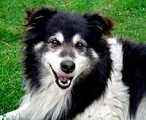 xa |
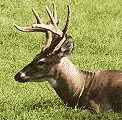 gowukàn |
 gòoch |
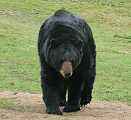 s'èek |
 xuluk'úch' |
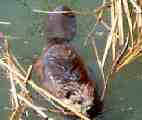 s'ugeidée |
 kots'èen |
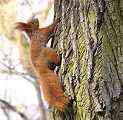 kunuls'ák |
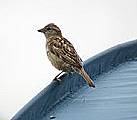 ts'ítskw |
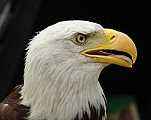 ch'ák' |
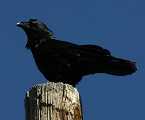 yéil |
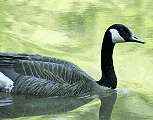 t'awúk |
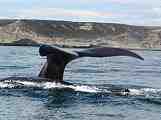 yáy |
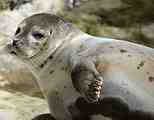 tsàh |
 xáat |
 gundas'ajée |
What was Tlingit culture like in the past? What is it like now?
Here's a link to the homepage of the Taku River Tlingit First Nation in Canada. There you can find information about the Tlingit tribe in the past and today.
How do Tlingit Indian children live, and what did they do in the past?
They do the same things any children do--play with each other, go to school and help around the house. Many Tlingit children like to go hunting and fishing with their fathers. In the past, Indian kids had more chores and less time to play, just like early colonial children. But they did have dolls, toys and games to play. Like many Native Americans, Tlingit mothers traditionally carried their babies in cradleboards on their backs--a custom which many American parents have adopted now.
What were men and women's roles in the Tlingit tribe?
Tlingit women gathered plants and herbs and did most of the child care and cooking. Men were fishermen and hunters and sometimes went to war to protect their families. Both genders took part in storytelling, artwork and music, and traditional medicine. The Tlingit chief was always a man, but the clan leaders could be either men or women.
What were Tlingit homes like in the past?
The Tlingits lived in rectangular cedar-plank houses with bark roofs. Usually these houses were large (up to 100 feet long) and each one housed several familes from the same clan (as many as 50 people.) Here are some pictures of Native American homes like the ones Tlingit Indians used. Today, old-fashioned buildings like these are still made from cedar wood, but they are only used for ceremonial purposes. Tlingit people live in modern houses and apartment buildings, just like you.
Plank Houses
Plankhouses are Native American homes used by tribes of the Northwest Coast (from northern California all the way up to Alaska.) Plank houses are made of long, flat planks of cedar wood lashed to a wooden frame. Native American plank houses look rather similar to old European houses, but the Indians didn't learn to build them from Europeans-- this style of house was used on the Northwest Coast long before Europeans arrived.
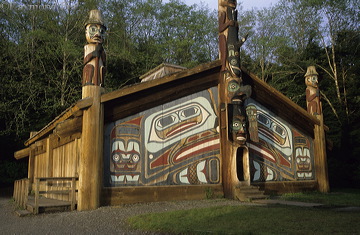
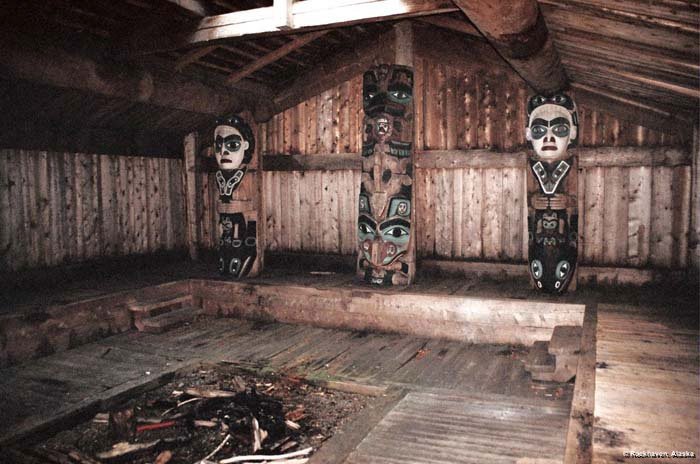
Plank houses are good houses for people in cold climates with lots of tall trees. However, only people who don't need to migrate spend the time and effort to build these large permanent homes. Most Native Americans who live in the far northern forests must migrate regularly to follow caribou herds and other game, so plank houses aren't a good choice for them. Only coastal tribes, who make their living by fishing, made houses like these.
What was Tlingit clothing like? Did they wear feather headdresses and face paint?
Tlingit men usually wore only breech cloths and the women only short skirts made of cedar bark. Further inland, where the weather was colder, women wore longer deerskin dresses and men wore Athabaskan-style pants with moccasins attached. Even in the snow, most Tlingit women preferred to go barefoot, but men on winter hunting trips would often wear snowshoes. For formal occasions, Tlingit people wore more elaborate outfits, with tunics, leggings and cloaks painted with tribal designs. One special clothing item of the Tlingits was the spectacular Chilkat blankets, which were woven from cedar bark and mountain goat hair.
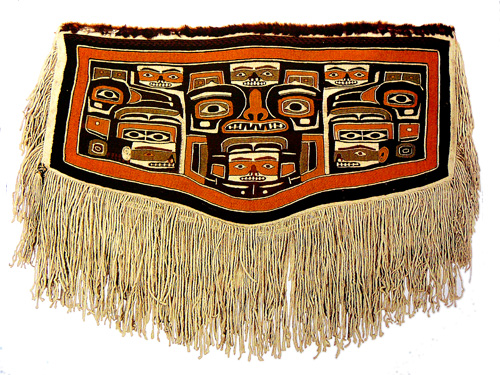

The Tlingits didn't wear long headdresses like the Sioux. Instead, both men and women sometimes wore basketry hats made of finely woven spruce root. The designs and patterns of these hats often displayed a person's status and family connections. The Tlingits painted their faces with different colors and designs for different occasions, and often wore tribal tattoos. Tlingit women often wore their hair in two long braids, while men usually left theirs long and loose. Like other Northwestern Indians, Tlingit men often wore mustaches and beards.
Today, some Tlingit people still have a traditional cloak or basket hat, but they wear modern clothes like jeans instead of breechcloths.
What was Tlingit transportation like in the days before cars? Did they paddle canoes?
Yes, the Tlingit Indian tribe was made dugout canoes by hollowing out spruce and cedar logs. The Tlingit tribe used these canoes to travel up and down the sea coast for trading, fishing and hunting, and warfare. Their most impressive war canoes, which could be more than sixty feet long and withstand ocean storms, were bought from the Haida tribe, who had access to the best cedar trees and were considered the best canoe-makers by the other Northwest Coast tribes. Here is a good website about Northwest Indian canoes. Today, of course, Tlingit people also use cars... and non-native people also use canoes.

What was Tlingit food like in the days before supermarkets?
The Tlingit Indians were fishing people. Tlingit men caught fish and sea mammals from their canoes. They also hunted deer, mountain goats, and birds. Some Tlingit bands, who lived further inland, relied more on big game like caribou and moose. Tlingit women gathered shellfish, seaweed, berries, and roots.
What were Tlingit weapons and tools like in the past?
Tlingit fishermen used harpoons, bone fishhooks, and wooden fish traps. Hunters used bows and arrows or spears, and trappers used snares and nets. In war, Tlingit men fired their bows or fought with spears and war clubs. Some Tlingit warriors wore bulky armor made of wooden rods lashed together to protect themselves from enemy archers.
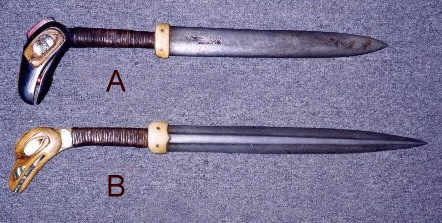
A. Athabaskan Tlingit Indian fighting knife of the Pacific North West, with finely carved wood head in the form of a raven and abalone shell eyes, leather bound grip, bone collar with bronze pins. Blade stamped " J. Wilson Sycamore St. Sheffield England Forged". Also has two fur trade type stamps on 10.25" blade. 19th Century. 16.75" O\A Provenance: Thomas Richards Collection. Head and grip restored by Peter Grant C. 1980. SOLD
B. Athabaskan Tlingit Indian fighting knife of the Pacific North West, with finely carved bone handle and abalone shell inlay, leather wrap grip and bone collar with bronze pins, tapered ridged 12" unmarked blade 18.75" O\A. Late 19th Century. Provenance: Thomas Richards Collection. Grip, collar and abalone shell restored by John Livingston C. 1980. (Native Totem Pole carver )
What are Tlingit arts and crafts like?
Tlingit artists are known for their fine basket and carving arts, including totem poles, and for their exceptional Chilkat robes and other weavings. Here is a website about Tlingit artwork in general.
What other Native Americans did the Tlingit tribe interact with?
The Tlingits traded regularly with all the other tribes of the Northwest Coast and the far north, particularly the Haida and Tsimshian tribes. Chiefs from other tribes especially desired Tlingit Chilkat blankets, which were famous for their great beauty, and the Tlingits liked to buy shells for jewelry and the masterful canoes of the Haidas. The Northwest Coast tribes also fought each other frequently, raiding each other's villages to steal wealth and capture slaves.
What kinds of stories do the Tlingit Indians tell?
There are lots of traditional Tlingit legends and fairy tales. Storytelling is very important to the Tlingit Indian culture. Here is one Tlingit legend about the origin of mosquitoes.
What about Tlingit religion?
Religions are too complicated and culturally sensitive to describe appropriately in only a few simple sentences, and we strongly want to avoid misleading anybody. You can visit this site to learn more about the Tlingit religion or this site about Native American religion in general.